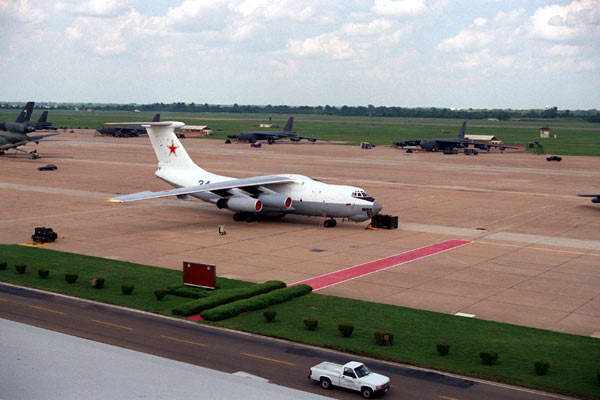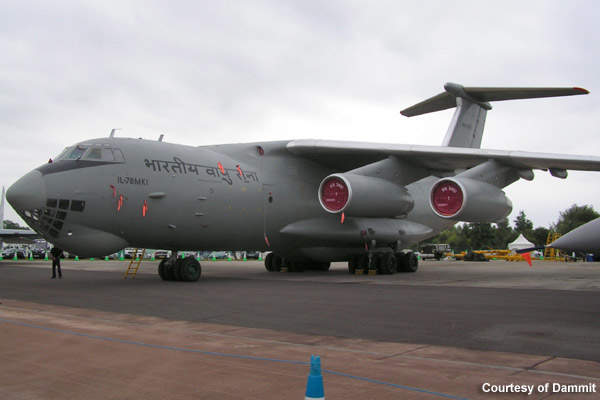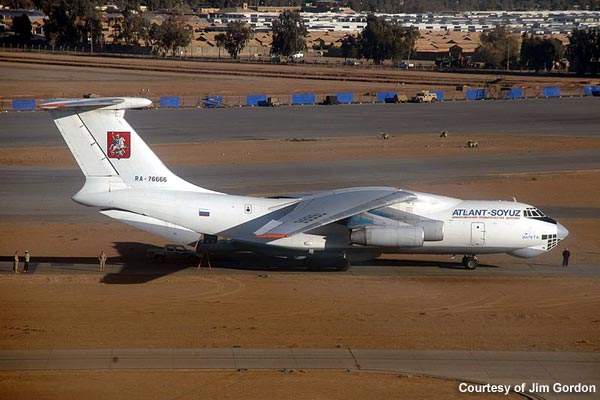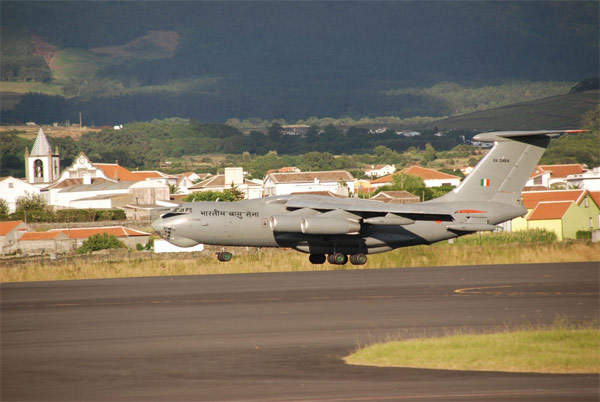The Ilyushin IL-78 air-to-air refuelling tanker aircraft is a four-engine tanker principally used for in-flight refuelling. It was designed and developed on the basis of a similar predecessor, the IL-76, and has the Nato reporting name Midas. The maiden flight of IL-78 took place on 26 June 1983 and the aircraft entered into service in 1984. About 53 aircraft are currently operational worldwide.
The IL-78 aircraft can refuel a maximum of four planes simultaneously on the ground. It can also be used as a military transport aircraft for air drop and air landing of cargo and crew.
IL-78 aerial refuelling tanker variants
The IL-78 has five variants, namely IL-78T, IL-78M, IL-78ME, IL-78MKI, and IL-78MP.
IL-78T is an alternative version of the IL-78 primarily used for holding all cargo handling equipment and convertible freight.
Another variant, the IL-78M, is a consecrate tanker aircraft designed to perform only refuelling operations without being able to be converted into transport aircraft. It is equipped with three permanent fuselage tanks. The IL-78M took its maiden flight on 7 March 1987.
The IL-78ME is an export version of IL-78M.
The IL-78MKI is a tailor-made variant of IL-78M and is equipped with Israeli fuel-transferring systems. These aircraft were deployed by the Indian Air Force (IAF) and can refuel six to eight Sukhoi Su-30MKIs in a single operation. The variant took its maiden flight on 11 January 2003.
The IL-78MP is a multipurpose aerial-refuelling tanker or transport aircraft. It is fitted with removable fuel tanks in the cargo hold and UPAZ refuelling pods.
These aircraft are deployed by the Pakistani Air Force (PAF) and can be easily converted to transport aircraft by removing the fuel tanks.
Midas orders and deliveries
In December 2008, the PAF signed an agreement with Ukraine to procure four IL-78 refuelling aircraft equipped with Russian-designed UPAZ refuelling pods.
The first IL-78 aircraft was delivered in December 2009. The second was delivered in 2010 and the third tanker in February 2011. The fourth is yet to be delivered.
The Indian Air Force (IAF) placed an order for six IL-78s in 2003. The first refuelling aircraft equipped with Israeli-made aerial refuelling pods was delivered to IAF in March 2003. The IL-78 has a total fuel carrying capacity of 110,000kg.
The deliveries to IAF were completed in 2004. The aircraft have been deployed at the Agra Air Force Base in India.
The People’s Liberation Army Air Force procured four IL-78s in 2005. The Russian and Ukrainian Air Forces operate 19 and eight IL-78 aircraft respectively.
IL-78 development
The IL-78 is derived from the IL-76. It was designed and developed by Ilyushin Aviation Complex, Russia to meet the requirements of Russian Air Force.
The aircraft was developed as part of the tanker project in 1982 to enhance the transferable fuel load of the earlier version IL-76. The IL-78 was developed as a three point air-to-air probe and drogue tanker aircraft and can deliver fuel at the rate of 900l to 2,200l a minute.
The new-generation aircraft (IL-78) is equipped with two removable 18,230l fuel tanks installed in the freight hold affording a transferable load of 85,720kg (188,584lb) with hold tanks and 57,720kg (126,984lb) without hold tanks as compared with the IL-76’s transferable fuel load of 10,000kg. It is also fitted with a fuel jettison system at the wing tips.
The IL-78M variant is fitted with an additional freight hold tank on the fuselage section. It has increased the transferable fuel to 105,720kg (233,070lb) and the maximum take-off weight (MTOW) to 210,000kg to strengthen the wing torsion box. All cargo doors and cargo handling equipment were removed from the aircraft, reducing the structural weight by 5,000kg. Out of the total 138,000kg cargo, only 105,720kg is transferable.
A convertible refuelling tanker aircraft, the IL-78MK is developed based on the IL-78M. The IL-78MK can refuel three types of aircraft simultaneously in air or four aircraft on the ground using traditional refuelling tubes extending from the cargo hold.
The IL-78MK-90 is derived from IL-78MK. It is powered by PS-90A-76 turbofan engine, which has increased the cruise speed to 850km/h. The take-off and landing distances of the IL-78MK-90 are 1,550m and 40m respectively.
Refuelling
The primary air fuel transfer method is done through the UPAZ-1A (Il-78) or UPAZ-1M (Il-78M) refuelling units equipped to the outer wings and rear fuselage controlled by an operator located at the flight engineer’s station in the cockpit. The receiver’s aircraft is equipped with homing radar behind a broad flat aft-facing radome, which facilitates the efficient refuelling process.
The IL-78 is fitted with wing-tip hose and drogue air refuelling pods. The receiving aircraft approaches the tanker and its probe makes contact with a hose reeled out and trailed from the tanker.
Inside the refuelling pods, a collapsible funnel-shaped drogue is attached to a hose, which is reeled out to trail behind the wing of the aircraft. The hose is fitted with a constant tension spring to give stability while it is extended.
IL-78 cockpit
The IL-78 has a glass cockpit that features five seats for two pilots, a communication officer, a navigator and a flight engineer. The two pilots sit at the front of the cockpit and just behind it is a seat reserved for the flight engineer. The outer corner of the flight engineer’s seat is meant for the communication officer. One deck below the glass nose is the navigator’s chair.
Avionics
The avionics of the IL-78 include an integrated (automated) flight control and navigation system with a compass system, ground surveillance radar, a central digital computer, an automatic monitoring (AMS) and automatic flight control system (AFCS), a short-haul radio navigation and landing system, an identification friend or foe transponder (IFF), an optical / infrared aiming sight and a ground collision warning system (GCWS).
Other avionics installed in the aircraft include distance measuring equipment (DME), dual very-high-frequency (VHF) navigation / communication and X-band colour weather radar in the nose.
It is also fitted with a traffic collision avoidance system (TCAS), a global positioning system (GPS), a cockpit voice recorder / flight data recorder (CVR/FDR), an instrument landing system (ILS) and a tactical aid for navigation (TACAN) system.
Cargo
Six crew and up to 138,000kg cargo can be carried on the cargo deck above the refuelling systems.
Aviadvigatel D-30 KP turbofan engines
The IL-78 is powered by four Aviadvigatel D-30 KP turbofan engines. Each engine can produce a maximum take-off thrust of 118kN. It is a two-shaft, low-bypass turbofan engine equipped with two spool compressor and mixed flow.
The D-30 KP turbofan engine is primarily used for short-haul airplanes for passenger transportation. The length and fan tip diameter of the engine are 3.98m and 1.05m respectively.
IL-78 performance
The IL-78 can fly at a maximum speed of 850km/h. The range and service ceiling of the aircraft are 7,300km and 12,000m respectively. The aircraft weighs around 72,000kg and the maximum take-off weight is 210,000kg.












